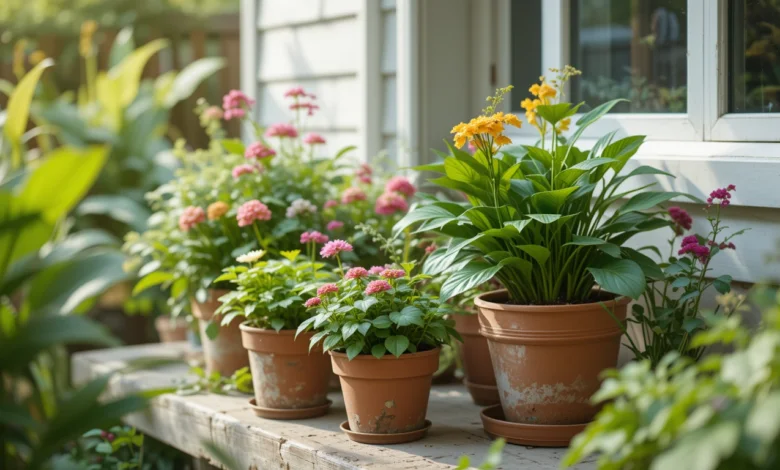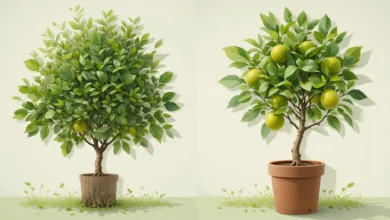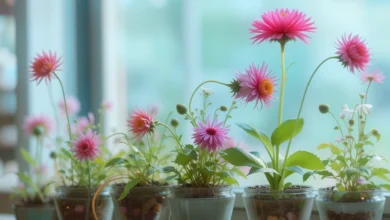How to Move Indoor Plants Outside for Spring & Summer

Spring and summer are the perfect times to give your indoor plants a chance to enjoy the sunshine and fresh air. Moving indoor plants outside can help them grow better, but it’s important to do it in the right way. If you don’t, your plants could get stressed or even damaged. But don’t worry! In this easy-to-follow guide, we’ll show you how to move your indoor plants outside for spring and summer, so they stay healthy and thrive.
Let’s get started!
Why Move Indoor Plants Outside?
Before we talk about how to move your plants, let’s first understand why it’s a good idea. Moving your indoor plants outside during spring and summer offers several benefits:
1. More Sunlight
Indoor plants often don’t get as much sunlight as they need. Bringing them outside will give them plenty of natural light, which is essential for photosynthesis (the process that allows plants to make their food). Sunlight will help them grow stronger and healthier.
2. Fresh Air
The fresh outdoor air contains higher levels of oxygen and carbon dioxide, which plants need to grow. It also helps reduce the chances of pests and diseases that are more common indoors.
3. Better Growth
Many plants, like flowers, vegetables, and herbs, grow better outdoors. The outdoor environment provides more space for their roots to spread out, allowing them to grow bigger and produce more flowers or fruit.
4. Healthier Plants
Moving plants outside can help them become more resistant to diseases and pests. Plus, the change in environment can help them grow faster, bloom better, and have more vibrant colors.
When Should You Move Indoor Plants Outside?
Timing is key when moving your plants outside. You don’t want to move them too early when the weather is still cold, or too late when it’s already too hot. Here are some general guidelines to help you decide the best time:
1. Wait Until All Frost Risks Are Gone
If you live in an area that gets frost, wait until the last frost date has passed. Frost can damage the leaves and flowers of your plants. You can check your local frost dates online or in gardening books to know when it’s safe to move your plants outside.
2. Temperature Should Be Just Right
Most indoor plants prefer temperatures between 60°F and 75°F (15°C to 24°C). Make sure the weather is warm enough before moving your plants outside. If the temperature is too hot, your plants might get stressed. On the other hand, if it’s still chilly at night, it could harm them.
3. Gradual Acclimation
Don’t suddenly move your plants outside all at once. Plants need to acclimate (get used to) the new environment gradually. It’s best to start with a few hours of outdoor time each day and slowly increase the amount of time they spend outside.
Read More: How to Grow Flowers Indoors – Easy Tips for Stunning Blooms
How to Move Indoor Plants Outside: Step-by-Step Guide
Now that we know the why and when, let’s dive into the how. Moving your indoor plants outside doesn’t have to be complicated. Here’s a simple step-by-step guide to help you do it right:
Step 1: Check the Weather
Before moving your plants outside, make sure the weather is warm and sunny, but not too hot. Plants are sensitive to extreme temperatures, so you want to avoid windy, stormy, or extremely hot days.
Step 2: Choose the Right Spot
Pick a good location for your plants. Most plants need indirect sunlight when first moved outside. Too much direct sunlight can burn their leaves. A shaded or partially shaded area is ideal at first. After a few days, you can move them to a sunnier spot if they seem to handle it well.
Step 3: Start Slowly
If your plants have been inside for a while, they are not used to the full strength of the sun or outdoor conditions. Start by placing them outside for just 2-3 hours a day. Gradually increase the time over the course of one to two weeks. This gradual exposure will help your plants avoid sunburn and shock.
Step 4: Protect from Wind
Strong winds can damage your plants, especially those with delicate stems or leaves. If it’s windy where you live, make sure to place your plants in a sheltered area, like near a fence or wall, to protect them from wind damage.
Step 5: Water Them Well
Outdoor plants often dry out faster than indoor plants because of the heat and wind. Make sure to water your plants regularly, but don’t overwater them. The soil should be damp but not soaking wet. A good rule of thumb is to water your plants when the top inch of soil feels dry to the touch.
Step 6: Monitor for Pests
Outdoor plants are more likely to attract pests like aphids, snails, and caterpillars. Regularly check your plants for any signs of bugs or damage. If you find pests, you can wash the plant with water or use organic pest control methods to get rid of them.
Step 7: Bring Them Back Indoors (If Needed)
If the weather gets too hot or cold, or if there’s a sudden storm, you might need to bring your plants back inside. Keep an eye on the forecast, and move your plants indoors if the temperature drops or a strong storm is expected. It’s better to be safe than sorry!
Common Mistakes to Avoid When Moving Indoor Plants Outside
Even though moving plants outside can be easy, some common mistakes can harm your plants. Here are a few things to watch out for:
1. Moving Plants Outside Too Early
As mentioned earlier, moving plants outside too early, before the risk of frost has passed, can harm them. Be sure to check the local weather and frost dates before making the move.
2. Not Gradually Acclimating Your Plants
Plants that have been indoors for a long time may experience shock if they are suddenly exposed to full sunlight or the outdoor environment. Make sure to acclimate them gradually, so they can adjust to the changes.
3. Overwatering or Underwatering
Outdoor conditions can cause your plants to need more water than they did inside. However, don’t overdo it. Too much water can lead to root rot, while too little water can cause your plants to wilt. Check the soil regularly to keep it at the right moisture level.
4. Forgetting About Pests
Outdoor plants are more vulnerable to pests, so make sure you check your plants regularly for bugs or diseases. If you notice pests, act quickly to get rid of them.
5. Leaving Plants Outside During Extreme Heat
While most plants enjoy the warmth of spring and summer, some can get stressed during extreme heat. If you notice your plants wilting or turning yellow, consider moving them to a cooler spot or bringing them inside during the hottest part of the day.
What Plants Are Best for Moving Outdoors?
Not all indoor plants will thrive outside, and some may struggle with outdoor conditions. Here’s a list of plants that generally do well when moved outside in the warmer months:
- Herbs: Basil, mint, and rosemary love the sunshine and are easy to grow outdoors.
- Flowers: Geraniums, marigolds, and petunias thrive in outdoor gardens and enjoy the sun.
- Vegetables: Tomatoes, peppers, and lettuce grow better outside with plenty of sunlight.
- Foliage Plants: Ferns and spider plants can tolerate outdoor conditions with partial sunlight.
Plants to Avoid Moving Outdoors:
- Tropical Plants: Plants like palms and ferns that need high humidity might struggle outside unless the weather is warm and humid.
- Succulents: While they love sunlight, succulents can get damaged in heavy rain or intense heat.
- Delicate Houseplants: Some houseplants, like the sensitive maidenhair fern, may not handle outdoor conditions well.
Conclusion
Moving your indoor plants outside for spring and summer is a great way to give them a fresh boost of energy and allow them to grow bigger and better. Just remember to follow the right steps for acclimating them, provide the right care, and monitor them regularly for pests. With a little bit of time and patience, your plants will thrive in their new outdoor home, adding beauty and freshness to your space.
Now that you know how to move your plants outside, it’s time to get started! Happy gardening!




